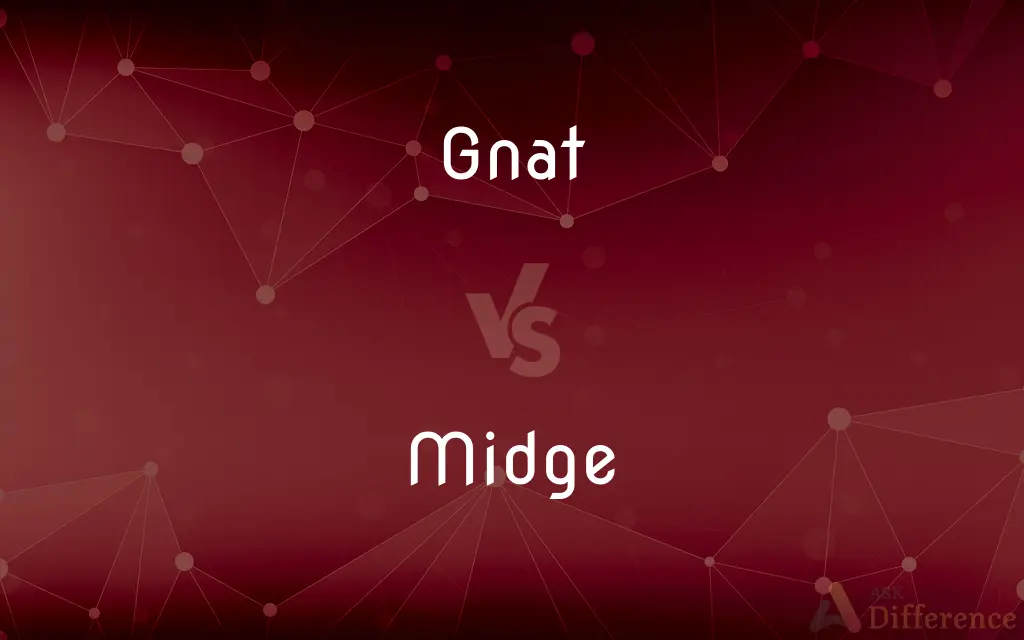Gnat vs. Midge — What's the Difference?
Edited by Tayyaba Rehman — By Fiza Rafique — Updated on March 26, 2024
Gnats are small flying insects often associated with damp environments and are known for their annoying swarms, whereas midges, including some gnats, can range from harmless plant feeders to biting pests, showing a broader behavior and habitat range.

Difference Between Gnat and Midge
Table of Contents
ADVERTISEMENT
Key Differences
Gnats are typically found in swarms near water bodies, moist soil, or decaying matter, attracted by moisture and organic material. These insects are known for their annoying presence around humans and animals, although most species are harmless. In contrast, midges encompass a wider variety of species, including those that do not bite and those that are known for their painful bites, especially in outdoor activities near water bodies or forests.
While gnats often refer to several species of small flying insects, including fungus gnats, fruit flies, and others that are non-biting, they play roles in decomposing organic matter and can be pests in homes and gardens. Midges, on the other hand, include both biting and non-biting varieties, with the former being a significant nuisance due to their bites that can cause irritation and, in some cases, transmit diseases.
In terms of habitat, gnats thrive in damp environments and are commonly found indoors around overwatered houseplants or rotting fruit. Their presence often indicates excessive moisture or decaying organic material. Midges have a similar preference for wet areas but are more commonly associated with natural bodies of water, where some species' larvae develop, making them more prevalent in outdoor environments.
Regarding control methods, managing gnats often involves reducing moisture levels, ensuring proper soil drainage, and removing decaying plant matter. These measures aim to disrupt the gnats' breeding and feeding grounds. For midges, control strategies can vary significantly, especially for biting species, where repellents, protective clothing, and environmental management, like reducing standing water, are commonly advised to mitigate their impact.
Both gnats and midges play ecological roles, with many gnat species involved in pollination and serving as food for larger insects, birds, and bats. Midges, especially non-biting types, are also important pollinators and a crucial food source in aquatic ecosystems, underlining their importance beyond their nuisance to humans.
ADVERTISEMENT
Comparison Chart
Definition
Small flying insects, often non-biting, found in moist environments.
A diverse group of small flying insects, including biting and non-biting species.
Habitat
Prefer moist soil, decaying matter, and overwatered plants.
Found near water bodies, both in urban and natural settings.
Diet
Larvae feed on fungi, algae, or decaying organic material.
Larvae vary from herbivores to predators, depending on the species.
Impact on Humans
Mostly nuisances, but can be pestiferous in homes and gardens.
Biting species can cause irritation or transmit diseases.
Control Measures
Reduction of moisture, removal of organic decay.
Use of repellents, environmental management, protective clothing.
Compare with Definitions
Gnat
A small, often non-biting flying insect that thrives in damp environments.
The overwatered houseplants became a breeding ground for gnats.
Midge
Small, flying insects that can be either biting or non-biting, found near water bodies.
Midges were particularly bothersome during our evening by the lake.
Gnat
Insects of the order Diptera, characterized by their short lifespan and rapid reproduction.
The gnats' lifespan is brief, but they reproduce quickly.
Midge
Biting midges can cause discomfort and allergic reactions in humans.
After the hike, we found ourselves covered in itchy bites from midges.
Gnat
Often associated with poor sanitation or overwatering of plants.
Gnats have become a nuisance in our kitchen, indicating we need to clean more thoroughly.
Midge
Includes species that serve important ecological roles, such as pollination and being a food source in aquatic ecosystems.
Midges, despite their nuisance, play a crucial role in the ecosystem.
Gnat
Any of various small insects, including fruit flies and fungus gnats, some of which are pests.
Gnats swarmed around the rotting apples in the orchard.
Midge
Control of biting midges focuses on personal protection and habitat management.
To avoid midge bites, we used insect repellent and wore long sleeves.
Gnat
Commonly found indoors in moist areas, such as kitchens and bathrooms.
Leaving damp towels around can attract gnats.
Midge
Non-biting midges are often seen in large swarms, especially near lights at night.
The streetlights were obscured by swarms of non-biting midges.
Gnat
(informal) An annoying person.
Midge
Minute two-winged mosquito-like fly lacking biting mouthparts; appear in dancing swarms especially near water
Gnat
A gnat () is any of many species of tiny flying insects in the dipterid suborder Nematocera, especially those in the families Mycetophilidae, Anisopodidae and Sciaridae. They can be both biting and non-biting.
Midge
A midge is any small fly, including species in several families of non-mosquito Nematoceran Diptera. Midges are found (seasonally or otherwise) on practically every land area outside permanently arid deserts and the frigid zones.
Gnat
Any of various tiny two-winged flies, especially those that sometimes form swarms.
Midge
Any of numerous small nonbiting flies of the family Chironomidae, having aquatic larvae and often forming large swarms near ponds and lakes. Also called chironomid.
Gnat
Any small insect of the order Diptera, specifically within the suborder Nematocera.
Midge
Any of various similar dipteran insects, such as the biting midges and the gall midges.
Gnat
Any fly resembling a Culex in form or habits; esp., in America, a small biting fly of the genus Simulium and allies, as the buffalo gnat, the black fly, etc.
Midge
Any of various small two-winged flies, for example, from the family Chironomidae or non-biting midges, the family Chaoboridae or phantom midges, and the family Ceratopogonidae or biting midges, all belonging to the order Diptera
Gnat
Any of various small biting flies: midges; biting midges; black flies; sand flies
Midge
(fishing) any bait or lure designed to resemble a midge
Gnat
British usage
Midge
Any one of many small, delicate, long-legged flies of the Chironomus, and allied genera, which do not bite. Their larvæ are usually aquatic.
Midge
A very small fly, abundant in many parts of the United States and Canada, noted for the irritating quality of its bite.
Common Curiosities
Are all gnats capable of biting humans?
No, many gnat species do not bite humans; they are primarily nuisances rather than health threats.
What attracts midges to humans?
Biting midges are attracted to carbon dioxide, heat, and certain chemicals in sweat, making humans and animals prime targets for their bites.
Can gnats cause damage to plants?
Yes, certain gnat larvae, like those of fungus gnats, can damage plant roots, particularly in overwatered soil conditions.
How can I reduce gnat infestations in my home?
Reducing moisture, improving soil drainage for houseplants, and removing decaying organic material can significantly reduce gnat populations indoors.
Are midges and mosquitoes the same?
No, while both belong to the order Diptera, midges are a distinct group and generally smaller than mosquitoes. Unlike mosquitoes, not all midges bite.
Do midges transmit diseases?
Some species of biting midges can transmit diseases to animals, but it is less common for them to transmit diseases to humans compared to mosquitoes.
Can gnats bite through clothing?
Most gnats, especially the non-biting types, are not capable of biting through clothing. Biting gnats may attempt to bite exposed skin.
How do midges survive the winter?
Midges can overwinter in the larval stage or as adults in protected areas, allowing them to emerge when the temperature rises.
Why do midges swarm?
Non-biting midges often swarm for mating purposes, especially around water or lights, where they are most visible.
What is the lifespan of a gnat?
The lifespan of a gnat can vary, but most adult gnats live for about 7 to 14 days, though their larvae stage may last longer.
What are natural predators of gnats?
Birds, bats, spiders, and other insects are natural predators of gnats, helping to control their populations.
Are there any beneficial types of midges?
Yes, many midge species are beneficial for pollination and as a food source for fish and other wildlife in aquatic ecosystems.
Share Your Discovery

Previous Comparison
Aqua vs. Hydro
Next Comparison
Assimilation vs. SocializationAuthor Spotlight
Written by
Fiza RafiqueFiza Rafique is a skilled content writer at AskDifference.com, where she meticulously refines and enhances written pieces. Drawing from her vast editorial expertise, Fiza ensures clarity, accuracy, and precision in every article. Passionate about language, she continually seeks to elevate the quality of content for readers worldwide.
Edited by
Tayyaba RehmanTayyaba Rehman is a distinguished writer, currently serving as a primary contributor to askdifference.com. As a researcher in semantics and etymology, Tayyaba's passion for the complexity of languages and their distinctions has found a perfect home on the platform. Tayyaba delves into the intricacies of language, distinguishing between commonly confused words and phrases, thereby providing clarity for readers worldwide.
















































